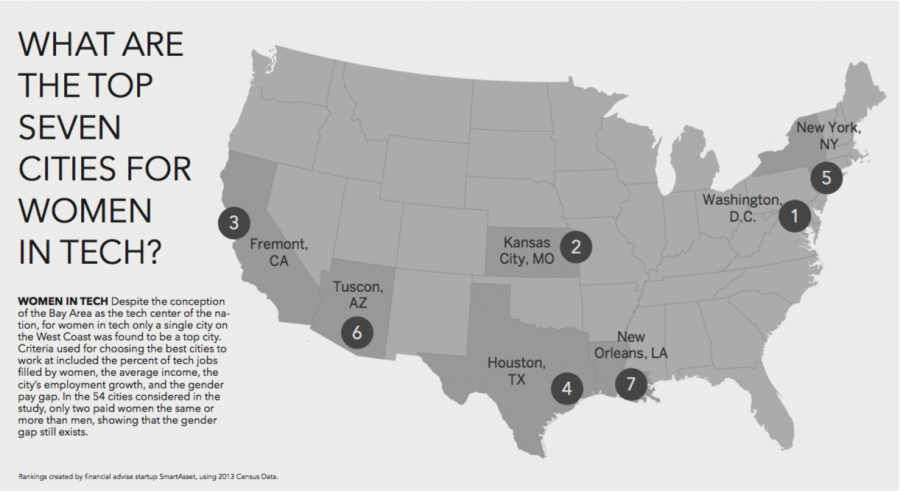The Diversity Gap
Tech industry strives to increase workplace diversity
March 4, 2016
Last year, Intel announced a goal of making 40 percent of their new employees female, African American, Latino or Native American, and earlier this month, the company announced that it had exceeded its target, reaching 43 percent.
Their news echoes that of industry leaders throughout the Bay Area trying to rectify the gender gap that leaves 26 percent of computing jobs in the hands of women, according to the National Center for Women in Technology (NCWIT)
As the 21st century technology continues to pervade the upper school, the Silicon Valley and the U.S., the numbers of women studying and pursuing computer science have sounded a warning bell as they fail to parallel the industry’s overall growth.
Diversity number goals, scholarships aimed at women and underrepresented minorities and groups like NCWIT have all pioneered ways to build a bridge over what is commonly referred to as a pipeline problem: throughout childhood and higher education, the number of women in computer science continuously drops, attributable to a myriad of factors including societal and cultural dissuasion.
Technology companies stand at the end of this supposed pipeline problem, replete with demographics that viscerally represent the gender gap and announcements of initiatives meant to decrease it.
Twitter announced specific goals last year for increasing the company’s percentages of women and underrepresented minorities in leadership, technical positions and the company overall.
Vijaya Gadde, Twitter’s General Counsel and Director of Communications, joined the company’s leadership team in 2013 and was the only woman on it at the time.
“We looked at what we wanted the representation to be over time and we wanted to show steady progress year by year,” Gadde said. “We picked goals that we felt would show that progress towards an ultimate, longer-term goal, and one that we felt was aggressive but that would be achievable and that we could build a plan [around].”
Twitter also has employee diversity groups within the company for women in engineering, Latinos, African Americans and LGBTQ+ employees. The women in engineering group’s website describes its goals as supporting and inspiring both the women at Twitter and young girls.
“Part of the work that we frontier is to really empower these groups to be a source for both professional development as well as connection and social culture within the company,” Gadde said. “That’s also one of the ways that we can make sure employees feel like they have a community here, because it’s as much about retaining the great, diverse talent we have as it is about recruiting new talent.”
Dropbox has similar diversity initiatives; the company supports employee resource groups, hosts unconscious bias recognition days and has recruiting initiatives to promote diverse hiring.
“When Dropbox was much smaller, [diversity initiatives were] more difficult because it was harder to get the critical mass we needed to make certain underrepresented groups feel more at home at the company,” Ramsey Homsany, General Counsel at Dropbox, said. “Also, the company was in survival mode, in a lot of ways. Rallying the troops and shifting people’s focus to those things is a little harder when the company is smaller and we have less resources. Now that we’re at the size we’re at, my guess is that [diversity] is a similar challenge to the challenges that larger companies have, especially in technology.”
Despite these companies’ new diversity proposals and hiring goals, their official diversity statistics from 2015 still indicate significant diversity imbalances in Silicon Valley. Among Twitter, Dropbox, Google, Facebook and Intel, women comprise less than a quarter of tech employees, and underrepresented minorities less than 15 percent.
“I see there is an increased awareness of the business importance of having more gender diversity in the workplace,” said Yanbing Li, Senior Vice President and General Manager in Storage and Availability at VMWare, a Dell subsidiary that specializes in cloud computing software. “What I’ve yet to see is how all this awareness, having a lot of activities and initiatives, has start[ed] to move the needle. Moving the needle means seeing real improvement in college pipelines or STEM related majors and for tech companies to start to see a real improvement for their women employee base and also for women to be far better represented in leadership positions. We know how hard it is to move the needle from a statistic point of view, but I’m sort of eager to see all the recent awareness pay off.”
The field of computer science especially has seen an overall drop in women in computer science and engineering in the past two decades. According to The Atlantic, the percentage of undergraduate computer science degrees going to women dropped from 37 percent in 1985 to 18 percent in 2010, and 0.4 percent of female college freshmen indicate interest in computer science as their major.
“I think in high tech in general, diversity has been pretty well valued over the course of my career,” Susan Roach, Director of Cloud Development Business Operations, at Oracle, said. “I think there are fewer women now than there were when I first started.”
According to the National Science Foundation, the percentage of undergraduate computer science degrees going to underrepresented minorities has risen from 13.9 percent in 1993 to 19.4 percent in 2012.
The aforementioned demographic breakdowns of tech employees do not match these percentages. Many companies have released goals for their diversity numbers by the end of 2016, and their results and inclusivity programs will continue to determine the future of diversity in the Silicon Valley tech industry.
Li feels optimistic about the role of the future generations of women in technology.
“I think there is a generation of women ahead of you pushing hard to crack the [glass] ceiling, and I think we’re making very good progress,” she said. “There are a lot of people blazing trails. My advice to young women is go for it. Technology is becoming more pervasive, and the opportunities are tremendous. Get support, get mentoring, connect with real role models [and] connect with people with experience.”
Q&A with Vijaya Gadde, General Counsel and Director of Communications at Twitter
Winged Post: Has being in the minority in a workplace every affected your decisions or actions?
Vijaya Gadde: I think being a woman and a person of color gives me a perspective on decisions when I’m thinking about the people that are using our platform and how they may react if we change certain types of features. We have a platform that is used by different people around the world of all different ethnic, gender, [and] racial background[s], and we want to make sure that the people that are here, building the product and building the company, are reflective of the people using the service in the world.
WP: In your career, how have you seen people’s attitudes on diversity and diverse culture in the workplace change?
VG: I’ve been in the workforce for about 16 years. I think what’s changed is that people always talked about it but people didn’t do very much. I think what you see now is a lot of people not just acknowledging that it’s not good, but acknowledging that doing nothing about it will not change it, and that we must take action. It’s not just about holding ourselves accountable, but that we need to make drastic changes to how we treat our employees within the company, where we find great talent, [and] how we recruit them.
WP: Is there a legal basis for a claim of reverse discrimination when companies try to implement these goals for hiring?
VG: I think there are certainly things that you could do that would result in a claim of reverse discrimination, and I think you have to, as a company, be mindful of not crossing that line, but I think that the types of things that most companies are focused on — in terms of looking at water pipelines of talented people from different schools — I wouldn’t view [those] as a high legal risk.
WP: You’re part of the investing group called the Angels. When you are looking at companies or researching them, how much of a role does their diversity play when you’re considering their company?
VG: It’s definitely something that we look at, but it’s not ultimately the deciding factor of whether we’ll invest or not. One of the reasons we started Angels was to make sure that we had access to be able to invest. As it is, [for] a lot of venture-backed companies, their investors tend to be mostly male, so we thought this was a good way to have women empower women investors, and also [for] our network of people we work with around the industry, to be able to introduce them to these great founders and get them into these great companies. Part of our goal in doing Angels is actually to help our portfolio companies become more diverse, and just because they’re not diverse we’ll still consider investing in them, but we definitely want to work with founders who share the same values that we do and share the same goals that we do.


